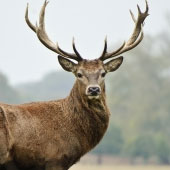
When it comes to red stag hunting, timing is everything. The difference between a good hunt and an unforgettable one often depends on when and where you choose to go. Pennsylvania’s varied seasons offer unique challenges and opportunities for hunters in search of trophy red stags, but one period of the year stands out as the optimal time for guided red stag hunting trips. Whether you’re planning your first trip or returning for another adventure, understanding the best time of year to hunt red stag at Tioga Ranch can help you maximize your success and enjoyment in the field.
Understanding the Red Stag Rut
Th breeding season for red stags is called “the rut.” During this time, red stag behavior changes dramatically. Typically occurring in early to mid-fall, the rut is when stags become most vocal, active, and territorial. They can often be heard roaring or “bugling,” a deep, resonant call used to establish dominance and attract females.
During this time, the normally cautious red stag becomes more active, as they move frequently throughout the day and sometimes venturing into more open areas. This heightened activity makes it easier for hunters to locate and find positions for success.
For most of Pennsylvania, including Tioga Ranch’s prime hunting grounds, the rut peaks between late September and early November. This window is considered the optimal time for red stag hunting.
A Season-by-Season Breakdown
While fall reigns supreme, each season at Tioga Ranch offers its own advantages for hunters. Understanding how red stag behavior changes throughout the year can help you plan your ideal hunt.
Spring
In spring, red stags are emerging from the winter months and beginning to grow new antlers. They feed heavily on fresh vegetation and move frequently to find food. Although this is not peak hunting season, spring hunts can be a good opportunity for those seeking a quieter experience and mild weather. =
Summer
During summer, red stags are less active as they conserve energy and focus on growing their antlers, which remain covered in velvet. The heat often drives them to shaded areas or near water sources, making them more predictable but harder to approach without disturbing them.
Fall
This is the time every red stag hunter waits for. As the air cools and the leaves begin to turn, the red stag rut takes center stage. Bucks compete for dominance, clashing antlers and bugling across the hills. Their increased movement and aggression make fall hunts both challenging and rewarding.
Winter
Once the rut ends, red stags return to more solitary behavior. They spend much of the winter recovering from the physical toll of the breeding season. Although hunting can still be productive in the colder months, success depends heavily on tracking and patience. Snow can make spotting and following tracks easier, but stags are more wary and less active.
If you’re ready to plan a red stag hunting trip, contact Tioga Ranch today to discuss available dates, packages, and accommodations.
